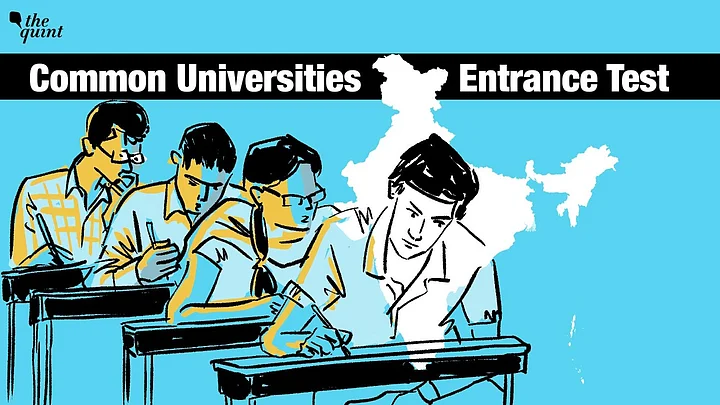Ending the wait for the Common University Entrance Test (CUET) announcement, the University Grants Commission (UGC) said that the test will be compulsory for admissions to undergraduate courses to the central universities, from the academic year 2022-23.
UGC Chairperson Mamidala Jagadesh Kumar addressed the media on Monday, 21 March, emphasising that admissions to the central universities via board results are being done away with, and that students will have to prepare for the common test instead.
The National Testing Agency (NTA) is likely to post details on the structure of the test on their website soon.
Who is eligible to take the test? What's the syllabus? Here's all you need to know.
Who should take the test?
Students who aim to secure undergraduate admission to any of the central universities that are funded by the UGC will have to appear for the exam. There are around 45 central universities that are funded by the UGC and some used to conduct their own tests previously.
How did these universities admit students previously?
Most of the universities used to admit students on the basis of their board examination results. Now, they can define eligibility based on board results but the final admission decision will rest on CUET scores.
Some colleges may use Board marks as the minimum eligibility criteria for admission. But it will no longer play a big role.
What about postgraduate students?
A few universities have also agreed to admit postgraduate students through CUET but the UGC has not made it mandatory for universities to do so as yet. Meanwhile, admission to PhD courses will not be affected.
What about professional courses like medicine or engineering?
For professional programmes, universities can continue to admit students on aptitude tests such as National Eligibility cum Entrance Test (NEET) and Joint Entrance Examination (JEE) scores. Admission to skill-based courses such as fine arts, theatre, and music will be done through practical examinations by the specific university, in addition to the CUET.
How can I prepare for the test?
The UGC chairperson said that the syllabus will 'mirror the class 12 syllabus.' Students will have to prepare from the class 12 NCERT (National Council of Educational Research and Training) syllabus. CUET will have three parts, and will only be Multiple Choice Questions (MCQ)
First, the student's reading and comprehension skills in one language will be tested. The student can also appear for an additional language.
In the second part, their domain knowledge will be tested. A student can choose up to six domain subjects to be tested on – this will depend on the course they choose.
The third part of the entrance test will be a general test with questions on general knowledge, logical and analytical reasoning, current affairs, etc.
In which language can I take the test?
According to the UGC, the test will give students flexibility with regards to their choice of languages. They would mandatorily have to choose from: Hindi, Marathi, Gujarati, Tamil, Telugu, Kannada, Malayalam, Urdu, Assamese, Bengali, Punjabi, Odia and English.
However, the candidate can also choose from the following as a second language option: French, Spanish, German, Nepali, Persian, Italian, Arabic, Sindhi, Kashmiri, Konkani, Bodo, Dogri, Maithili, Manipuri, Santhali, Tibetan, Japanese, Russian and Chinese.
What are the domain subjects?
The following are the domain subjects the students can choose to be tested on, according to The Indian Express:
Accountancy/ Book Keeping, Biology/ Biological Studies/ Biotechnology, Business Studies, Chemistry, Computer Science/ Informatics Practices, Economics/ Business Economics, Engineering Graphics, Entrepreneurship, Geography, History, Home Science, Knowledge Tradition–Practices India, Legal Studies, Commercial Arts, Mathematics, Physical Education/ NCC, Physics, Political Science, Psychology, Sociology, Teaching Aptitude, Agriculture, Mass Media/ Mass Communication, Anthropology, Fine Arts/ Visual Arts (Sculpture/ Painting), Performing Arts and Sanskrit.
Students can choose a minimum of one and a maximum of six.
But, how do I know which one to choose?
This depends on the programme you want to choose. Each university will list the domain test needed for admission to specific programmes.
What happens to minority institutions?
Implementation of the common entrance test has been debated upon in a few institutes. Aligarh Muslim University (AMU), whose minority status is sub judice, had previously said that they will stick to status quo with regard to admissions.
Article 30 of the constitution states, “All minorities, whether based on religion or language, shall have the right to establish and administer educational institutions of their choice.”
However, it has been made clear that the test is compulsory for all undergraduate courses to central universities. Minority institutes such as St Stephen's, which is a constituent of Delhi University, will also have to comply. The existing reservation policies of universities and institutes will not be affected.
When will the schedule be released?
Students can check the NTA website for dates and more details over the course of the next week. Stay tuned to this space for more information.
(At The Quint, we question everything. Play an active role in shaping our journalism by becoming a member today.)
